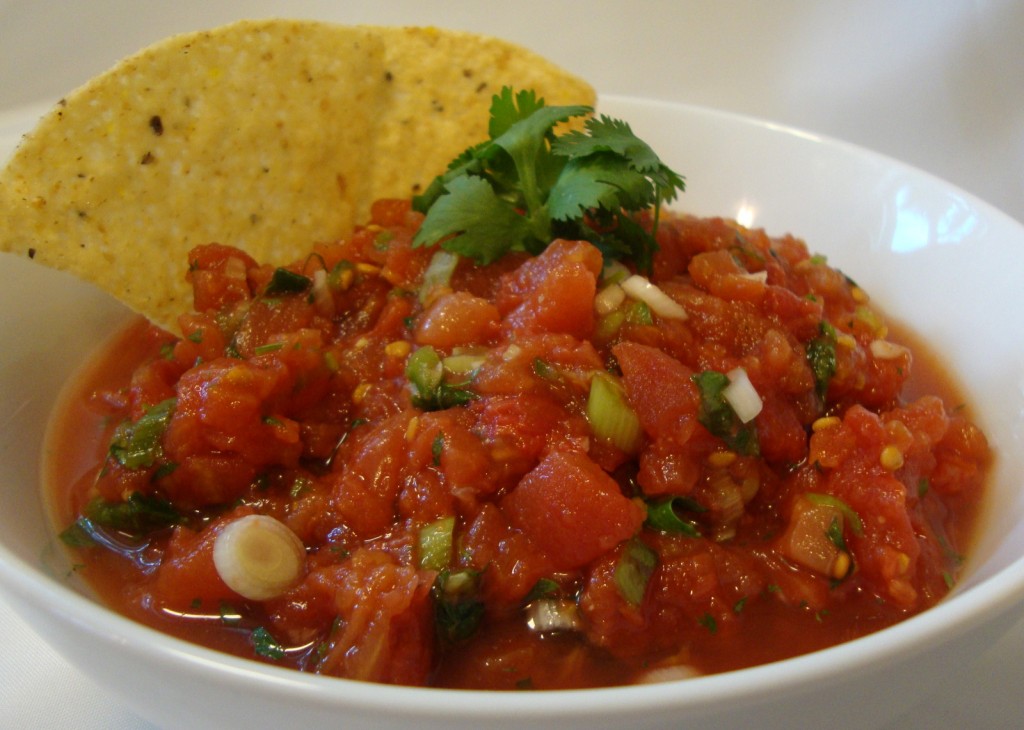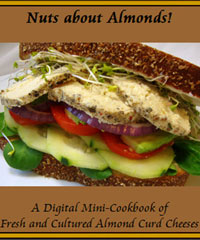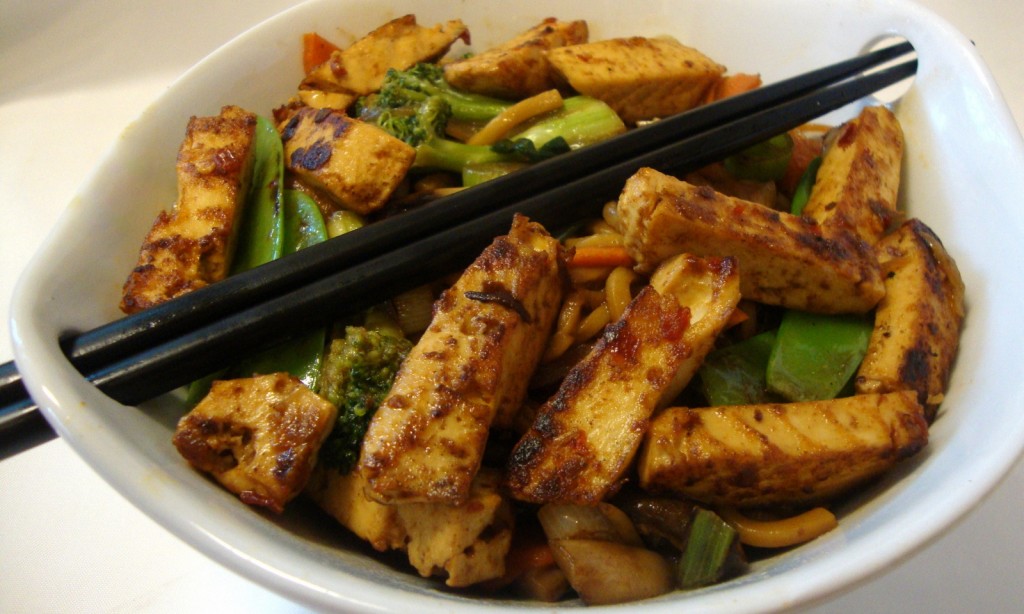
Stir Fry featuring Asian-Style Soy Chikun Strips
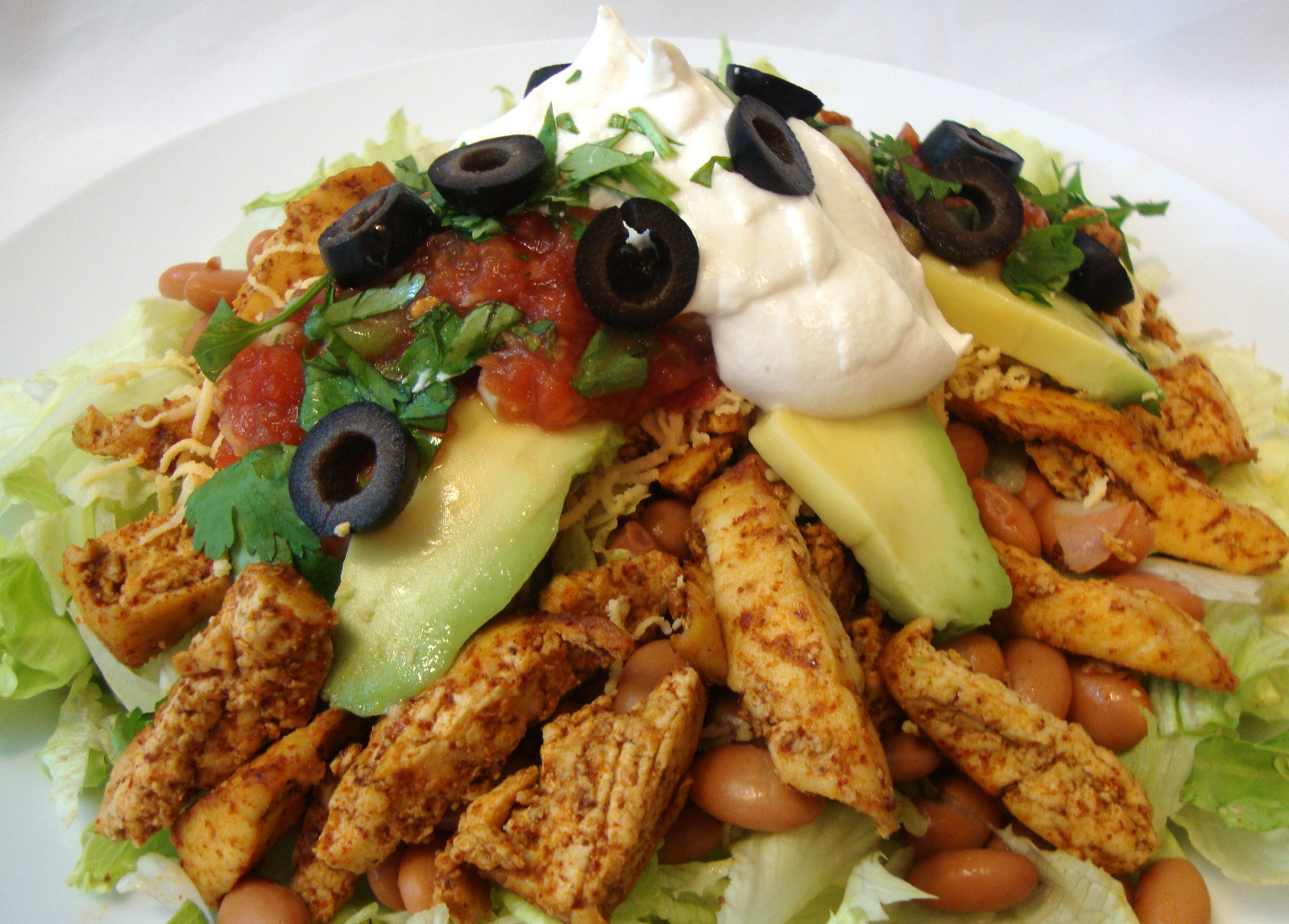
South of the Border Salad featuring Tex-Mex Soy Chikun Strips
These soy-based chikun strips are incredibly easy to make and remarkably resemble grilled strips of seasoned chicken. The ingredients are simple: tofu and a seasoning marinade. The secret is all in the preparation technique. A tofu press is recommended in order to compress the tofu properly and remove as much water as possible. However, the traditional plate and heavy weight method will work too, but the texture may not be as dense.
Each block of tofu will yield 8 ounces of prepared chikun. Most households do not possess more than 1 tofu press, so if you wish to prepare additional chikun strips, press the first block and then store in the refrigerator in an airtight container while additional blocks are pressed. For additional blocks, simply double or triple the water and seasonings in the recipe.
IMPORTANT! DO NOT use a toaster oven for baking the tofu!
Ingredients:
• 1 block (14 oz) extra-firm water-packed tofu (not silken tofu)
• ⅓ cup water
• 1 tsp nutritional yeast
• ½ tsp fine sea salt or kosher salt
• ½ tsp onion powder
• ¼ tsp poultry seasoning
• ¼ tsp garlic powder
Technique:
Press the tofu until thoroughly compressed and as much water has been removed as possible (keep stored in the refrigerator while pressing). This will take a minimum of several hours (overnight being ideal). Blot the tofu with a paper towel.
Preheat the oven to 350°F. Place a stainless steel cooking rack on a baking sheet and line with parchment paper. Place the block of tofu on the parchment paper and bake for 1 hour and 30 minutes. The tofu will develop a firm golden crust while baking. Let the block cool completely after baking.
Trim the crust from the block of tofu since it will be rather tough. Small amounts of crust may remain – that’s okay. For chikun strips, simply slice the tofu into strips. For shredded chikun, use the tines of a fork to tear off bite-size pieces. Place the strips or shreds into a zip-lock bag.
Now, in a small bowl, whisk together the remaining ingredients. The dry seasoning powders may take a moment to dissolve, so keep whisking until blended. Pour the seasoning marinade over the tofu in the bag. Press as much air out of the bag as possible; seal and refrigerate for several hours (overnight is best).
Note: Other herbs and spices can be added to the marinade to accommodate specific ethnic food flavors.
For a Tex-Mex variation, prepare the marinade with the basic recipe and add 1 tsp mild chili powder, an additional ½ tsp onion powder, ½ tsp ground cumin, an additional ¼ tsp garlic powder and ¼ tsp chipotle chili powder.
For an Asian Stir Fry variation, marinate and sauté the chikun as directed and add a dash or two of tamari while sautéing. Toss with a tablespoon of chili garlic sauce just before removing from the skillet.
For a Mediterranean variation, prepare the marinade with the basic recipe but reduce the water to ¼ cup. Add 1 T lemon juice, 1 tsp dried basil, 1 tsp dried oregano, an additional ½ tsp onion powder and an additional ¼ tsp garlic powder. Finish with fresh ground black pepper.
The strips or shreds are now ready to be pan-grilled or sautéed. This step is necessary to prepare the chikun for serving or using in recipes. Lightly oil a non-stick skillet with cooking oil and place over medium heat. Add the chikun including any residual marinade.
Sauté until the excess liquid has evaporated and the chikun is golden. Use a gentle touch while sautéing; the chikun is firm but can break apart excessively if stirred roughly. Use immediately in your favorite hot recipe or chill for use in cold recipes (wraps, salads, etc.) For soups, add the chikun the last 10 to 15 minutes of cooking time to avoid becoming too soft.
Store any leftovers in an airtight container in the refrigerator. Use within 5 days or freeze up to 1 month.
Print Recipe
Seasoned Tofu Chikun Strips
Votes: 2
Rating: 2
You:
Rate this recipe!
|
|
Votes: 2
Rating: 2
You:
Rate this recipe!
|
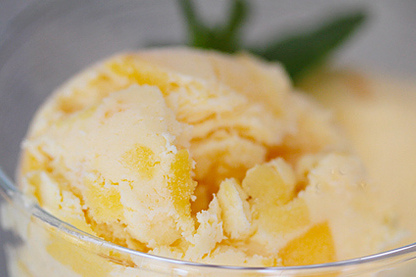
Heavy cashew cream and puréed fruit form the base for this delightful frozen treat. An ice cream maker is required for this recipe.
Ingredients:
• 1 cup (5 oz. by weight) whole raw cashews
• 2 cups non-dairy milk of your choice
• ¾ cup organic sugar
• ½ tsp guar gum
• 2 cups chilled fruit purée, smooth or semi-chunky
Technique:
Place the cashews and milk into a container with a lid, seal and place in the refrigerator to soak for a minimum of 8 hours. After soaking, place the ingredients in a high-powered blender and process on high speed for 2 full minutes.
The cream will now need to be strained to remove the solids. To do this, wash your hands thoroughly and pour the cream into the nut milk bag over a large bowl or pitcher.
While holding the top of the bag with one hand, gently knead the bag to help the cream pass through the ultra-fine mesh – avoid forcing the cream through. Discard or compost the solids in the bag.
Optionally, the cream can be poured (in increments) into a strainer lined with 4 layers of cheesecloth. Stir the cream gently with a spoon to help it pass through the cheesecloth.
Pour the heavy cream into a blender and add the sugar and guar gum; process until smooth. Pour the mixture into a container and refrigerate until very cold (or place in the freezer for about 30 minutes).
When well chilled, pour the cream mixture into your ice cream maker and add the chilled fruit purée. Process the mixture according to your ice cream maker’s instructions.
Print Recipe
Fresh Fruit Ice Cream (Cashew Cream Base)
Votes: 2
Rating: 5
You:
Rate this recipe!
|
|
Votes: 2
Rating: 5
You:
Rate this recipe!
|
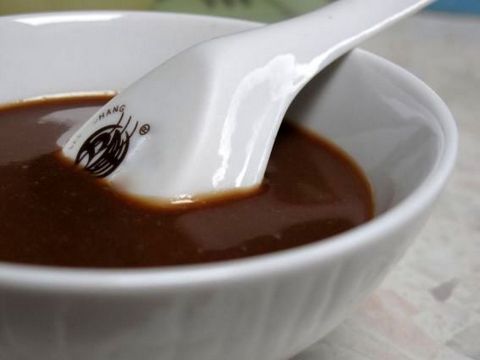
Hoisin is a thick, aromatic condiment sauce with a salty and sweet flavor. It is commonly used in Chinese cuisine as a grilling glaze (superb for seitan, tempeh and tofu); as an addition to stir fries; or as dipping sauce (try it with spring rolls). It is also used as a condiment for phở, the classic Vietnamese soup. My homemade variation contains no added sugar, starch, gums, starches, colors or preservatives, unlike most of its commercial counterparts, since the fruit naturally sweetens and thickens the sauce. This recipe yields about 1 and ½ cup.
Ingredients:
• 1 cup dark seedless raisins
• ⅔ cup water
• ⅓ cup tamari, soy sauce or Bragg Liquid Aminos™
• 2 T rice vinegar
• 1 clove garlic, chopped
• 2 tsp sesame oil
• ¼ tsp crushed red pepper
• ¼ tsp Chinese Five Spice powder
Technique:
Add all the ingredients to a small saucepan and bring to brief boil. Remove from the heat and let the mixture cool. Add the mixture to a blender and process until smooth, about 1 minute. Press through a fine mesh sieve back into the saucepan to catch any stray particles. Transfer to a sealable container and store in the refrigerator until ready to use; the sauce will thicken as it chills. Due to its salt and vinegar content, the sauce should remain preserved and fresh for a few weeks.
Print Recipe
Chef's Best Hoisin Sauce
Votes: 0
Rating: 0
You:
Rate this recipe!
|
|
Votes: 0
Rating: 0
You:
Rate this recipe!
|
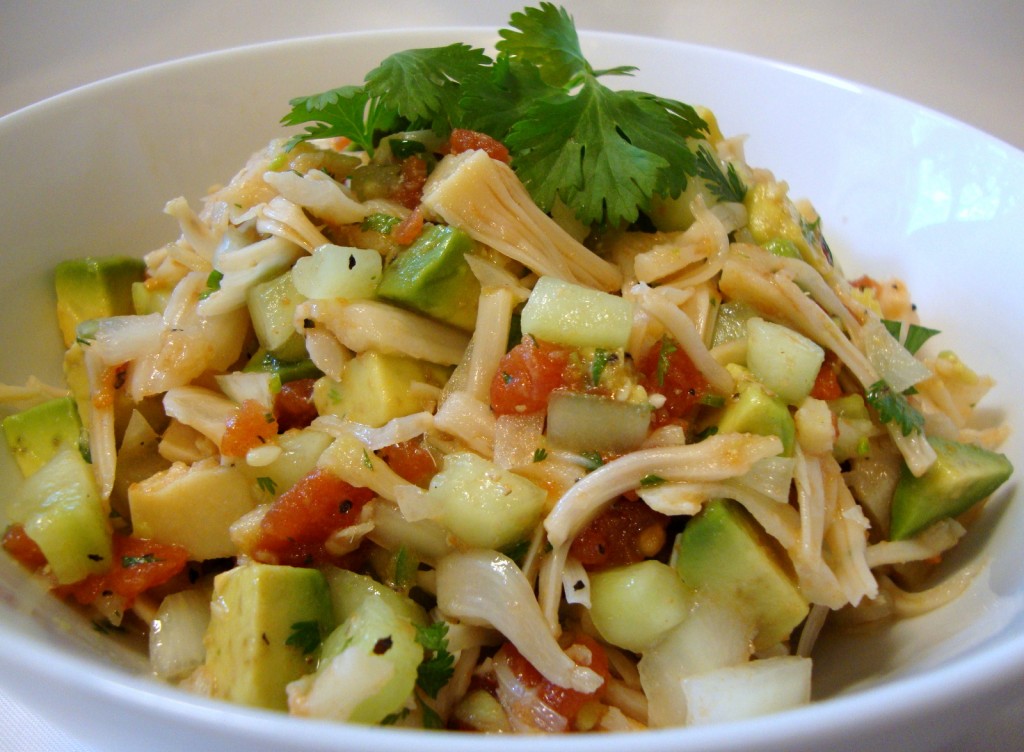 Ceviche (pronounced “seh-VEE-chay”) is a Latin American dish which traditionally consists of raw fish or shellfish marinated in citrus juice (usually lime and/or lemon juice). The acid in the citrus juice coagulates (denatures) the proteins in the seafood, effectively cooking it. Since no heat is used, the dish is served cold. There are many recipe variations combining the marinated fish/shellfish with a wide variety of other fresh ingredients such as onion, tomato, cilantro, chili peppers and avocado.
Ceviche (pronounced “seh-VEE-chay”) is a Latin American dish which traditionally consists of raw fish or shellfish marinated in citrus juice (usually lime and/or lemon juice). The acid in the citrus juice coagulates (denatures) the proteins in the seafood, effectively cooking it. Since no heat is used, the dish is served cold. There are many recipe variations combining the marinated fish/shellfish with a wide variety of other fresh ingredients such as onion, tomato, cilantro, chili peppers and avocado.
My plant-based version relies upon cooked unripe green jackfruit as a replacement for the fish/shellfish, since it has a neutral flavor which takes on the flavor of the marinade and a flaky texture reminiscent of cooked crab. The dish is essentially a zesty, marinated plant-based salad which is served cold as a refreshing appetizer with crispy corn tortilla chips. This recipe yields enough ceviche for 2 to 3 guests; for more simply multiply the recipe.
Ingredients:
• 1 can (20 oz) green jackfruit in water or brine
• ½ cup peeled and small diced tomato
• ½ cup peeled, seeded and small diced cucumber
• ¼ cup small diced onion
• ¼ cup chopped cilantro
• 1 clove garlic, minced
• 1 small Serrano chili, seeded and finely minced
• juice of 1 lime
• 1 T olive oil
• ½ tsp fine sea salt or kosher salt, or more to taste
• ¼ tsp coarse ground black pepper
• ¼ tsp ground cumin
• ½ ripe but firm avocado, diced
*Canned green jackfruit bears a resemblance to flaked crabmeat when cooked. It can be found in Indian and Asian markets or purchased through the internet. Look for the label “Green Jackfruit” or “Young Green Jackfruit” and be sure that it’s packed in water or brine and not syrup. Cans of ripe jackfruit packed in syrup may be stocked nearby, but don’t be tempted to substitute as the ripe fruit will be too sweet for this application.
Chef’s note: Traditional ceviche made with fresh seafood has a fresh, clean flavor and should not be fishy. If you wish to add a subtle ocean flavor to this plant-based version, add a little bit of dried kelp flakes or flaked, toasted nori.
Technique:
Drain the jackfruit and rinse. If the jackfruit was canned in brine, rinse thoroughly. Add the chunks of jackfruit to 1 quart salted boiling water. Reduce the heat to a slow boil and cook for 15 minutes. Drain in a colander and let cool. When cool enough to handle, remove the tough core from each chunk of jackfruit with a sharp knife and discard. Break the chunks apart with your fingers and remove the soft seeds and seed membranes and discard. The remaining flaky pulp is the only portion you will want to use in the dish, so sort through the chunks carefully (there will be a significant amount of unusable material). Wrap the pulp in a lint-free kitchen towel and squeeze to remove excess water. Coarsely chop the pulp and place in a mixing bowl.
Add the remaining ingredients EXCEPT for the avocado and toss well to combine. Refrigerate for several hours to marinate the ingredients and blend the flavors. Add the diced avocado just before serving and toss well. Season the ceviche with additional salt as desired and to taste. Serve with crunchy tortilla chips.
Votes: 4
Rating: 3.25
You:
Rate this recipe!
|
|
Votes: 4
Rating: 3.25
You:
Rate this recipe!
|
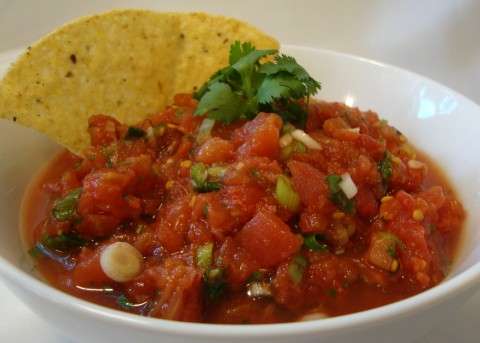
This fresh chunky garden salsa has a medium heat which can be adjusted to suit your taste. I chose canned whole tomatoes because they are partially stewed during the canning process, thus producing a superb texture for salsa. It’s very easy to make and so much better than store-bought. This recipe yields about 4 cups.
Ingredients:
• 2 cans (28 oz each) whole tomatoes
• 3 large scallions or 6 small scallions, white and green parts, finely chopped
• 2 large cloves garlic, finely minced (or 1 for timid palates)
• juice of 1 lime
• 1 small Serrano or jalapeno pepper, finely minced (about 1 T), or more to taste
(for a fiery salsa try including the seeds; for a milder salsa reduce or omit)
• ¼ cup chopped cilantro, or more to taste
• ¾ tsp fine sea salt or kosher salt, or more to taste
• ½ tsp ground cumin
Technique:
Remove the tomatoes from the can and finely dice, reserving any juice in the can for other uses, if desired. The tomatoes themselves contain a great deal of juice, so use a cutting board with irrigation channels if you have one; if not, dice 1 or 2 tomatoes at a time. Place the diced tomatoes in a mixing bowl and toss together with the remaining ingredients. Refrigerate for several hours to blend the flavors, ideally overnight.
Taste and add additional salt before serving, as desired. The salsa will keep for about 10 days in the refrigerator. Serve with your favorite tortilla chips; or use as a topping for your favorite Mexican or Tex-Mex recipes.
Print Recipe
Chef’s Favorite Garden Salsa
Votes: 0
Rating: 0
You:
Rate this recipe!
|
|
Votes: 0
Rating: 0
You:
Rate this recipe!
|









